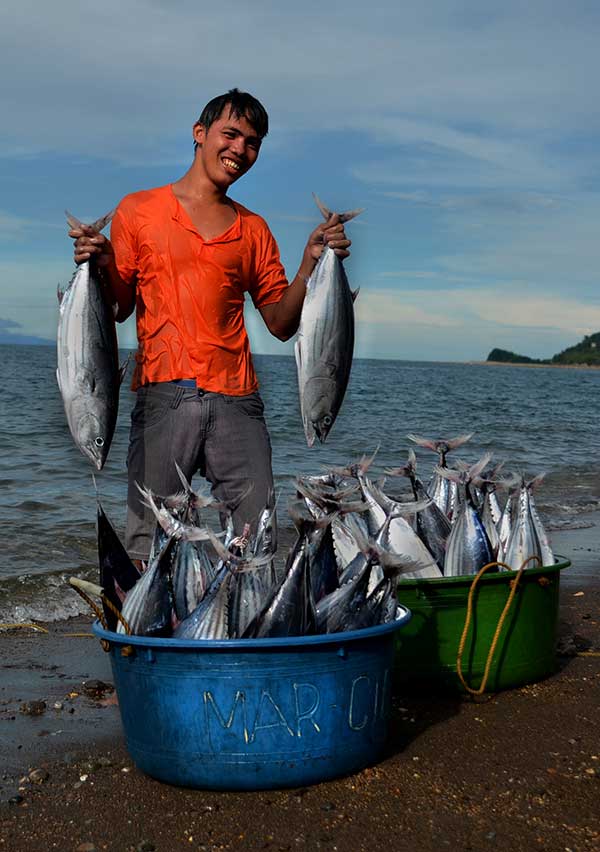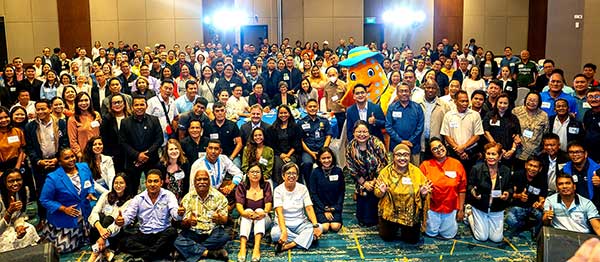To celebrate National Fisherfolks’ Day, over 200 people attended the National Coastal and Inland Fisheries Summit (NCFIS) last 31 May 2024 at the Radisson Park Inn Hotel in Quezon City.
First staged in 2019, the summit examined the past five years’ developments and passed fresh resolutions to strengthen local government capacities on five key themes: marine protected areas, climate change solutions, coastal and fisheries enforcement, sustainable financing and preferential rights for municipal fishers.
Organized by the Department of Agriculture’s Bureau of Fisheries and Aquatic Resources (DA-BFAR), Department of the Interior and Local Government (DILG) and international nonprofit organization Rare, the summit brought together representatives from the national and local government, civil society, fisheries groups and the academe.
An international delegation drawn from seven nations – Indonesia, Palau, Brazil, Guatemala, Honduras, Mozambique and the Philippines – also visited. “The Coastal 500 – mayors and other government leaders who have pledged to protect their coastal waters – embodies the best in network-building,” says Aya Silva, vice-president of Rare Philippines, introducing the delegates. “Hailing from different countries and diverse communities, they’re all linked by a promise to protect the one thing that surrounds us all – the sea.”
The Philippines is among the world’s largest archipelagos, with 70% of its municipalities lying along the coast. However, coastal communities remain among the poorest in the nation.
“Around 80% of our 2.2 million fishers are artisanal, among the poorest of the poor. The question is: how can we help them?” asks Lope Santos III, secretary of the National Anti-poverty Commission. “Perhaps we don’t realize it, but it is our fishers and farmers who put food on our tables. They’re our everyday heroes,” says Lilia Macrohon Nuño, BFAR’s national fisherfolk director. Filipino fishers earn a paltry PHP5000 to PHP10,000 monthly, which is barely enough to cover basic needs, adds BFAR OIC director Isidro Velayo, Jr.
For the first time, the summit included inland fisheries – seafood caught or farmed in Philippine rivers, lakes, ponds and streams. Indigenous fishers and their important traditional fisheries contribution were also highlighted. “Our ancestors have fished long before the coming of modern fishing boats,” recounts Fredel Mued, a native Tagbanua tribesman from Palawan. “You use GPS, sonar, radar – but we simply triangulated a coral reef or fishing spot’s location using landmarks like boulders, trees and distant mountain peaks.”
“The most effective way to protect the world’s most vibrant and productive coastal resources is to equip local communities with the proper tools to care for them,” says Lara Williams of Bloomberg Philanthropies. “What we need is strong local leadership for a collective impact.” The daylong summit tackled some of the most pressing challenges to coastal conservation.
COMBATTING ILLEGAL FISHING, BRACING FOR CLIMATE CHANGE
A top issue was Illegal, Unregulated and Unreported (IUU) fishing. “IUU fishing threatens the lives and livelihoods of fishing communities,” says BFAR undersecretary Drusila Bayate. “We need to fine-tune our recently amended Fisheries Code (RA-10654) to better combat IUU fishing.”
IUU fishing encompasses a whole range of illegal and destructive fishing methods: fishing in no-take zones, blast and cyanide fishing, using overly efficient fishing gear like fine mesh nets and illicit business practices like high-seas fish smuggling or mislabeling imported seafood products.
“We shall intensify our anti-illegal fishing efforts,” promises brigadier general Jonathan Cabal, director of the PNP’s national maritime group, which has so far arrested 774 fishing violators. “As it is difficult for our 3000 maritime group members to cover the entire archipelago, we shall first concentrate on our most productive areas.”
“Many of our fishers are informal settlers, their rights easily trampled by more powerful players,” reveals Ruperto ‘Ka Uper’ Aleroza, vice-chair for the national anti-poverty commission’s basic sector. “Commercial fishing vessels keep entering our municipal or coastal waters – waters within 15 kilometers from the coastline – to fish illegally. The sea has no fences, so we should learn to respect invisible boundaries.”
As coastal communities and fishers are among the most vulnerable to climate change, climate solutions were discussed. “Yesterday at the related Galing Pook event, we launched an innovative programme to help protect our fishers from increasingly unpredictable weather,” shares Dr. Israel Cruz, department manager of the Philippine Crop Insurance Corporation, which revealed that just 85,000 out of 13 million Filipino farmers and fishers have insurance.
“Our parametric insurance system uses weather index data such as rainfall, wave height and wind speed. Tranches of PHP1250 shall be credited to registered fishers when certain weather parameters are met. This is much faster than physically checking and calculating actual losses. Payouts can be available two weeks after the end of each month. The system is currently being fine-tuned and will be rolled out by October 2024,” says Cruz.
Philippine waters are among the richest on Earth. Forming the apex of the Coral Triangle, the country hosts 27,000 square kilometers of coral reef, hosting over 3000 fish species like whale sharks and manta rays, plus iconic sea critters like marine turtles and dugongs. Recent published studies however, revealed that over 90% of Philippine reefs are classified as either poor or fair – curtailing fisheries productivity.
“Perhaps a root cause of many of our challenges is hunger and poverty,” shares Del Carmen mayor Alfredo Corro II, who earlier toured members of the Coastal 500 around the island of Siargao, a surfer’s paradise and tourism hub smashed by Typhoon Odette in December 2021.
“For their lives to improve, we should see our fishers not as ‘the poorest of the poor’ – but as equals. They are fellow businessmen and women, entrepreneurs just like us. Perhaps when they reach the ripe age of 65, when their kids have all graduated, they can finally fulfill the dreams of their youth. Maybe they want to travel, to see more than where their old bancas have brought them. This is why we need social protection to improve their lives. This is why we’re all here.”

























